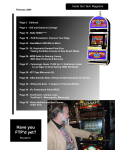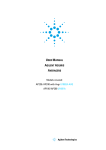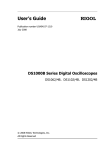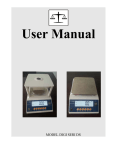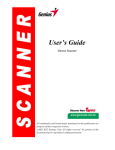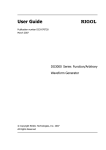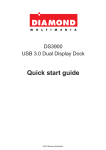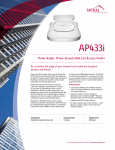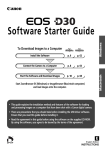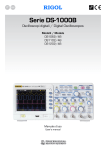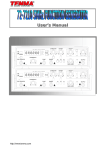Download Acute
Transcript
Acute Table of Contents Safety Information Safety Information........................................................................... 2 Chapter 1: Introduction What is Acute DS-1000 digital storage oscilloscope (DSO).............. 6 Packing list ...................................................................................... 7 Specifications................................................................................... 8 System Requirement ....................................................................... 10 Chapter 2: Installation Installation Procedures.................................................................... 12 Quick Start: (Calibration) ................................................................ 15 Chapter 3: Operations Screen.............................................................................................. 17 Channel Switch Button.................................................................... 17 VOLTS/DIV Knob .......................................................................... 18 SEC/DIV Knob ............................................................................... 18 Main Function Button ..................................................................... 18 Sub-Function Button ....................................................................... 18 Short-cut #1 Function Button: RUN/STOP Button.......................... 19 Short-cut #2 Function Button: Force Trigger ................................... 19 Short-cut #3 Function Button: AUTOSET........................................ 19 Panel Switch Button ........................................................................ 20 Simple Panel.................................................................................... 20 Threshold ........................................................................................ 21 Channel ........................................................................................... 21 Scroll Bar ......................................................................................... 21 Panel Sizing Knob ........................................................................... 21 Trigger............................................................................................. 21 Chapter 4: Functionality Trigger............................................................................................. 23 Display ............................................................................................ 23 Cursor.............................................................................................. 24 Measurement .................................................................................. 25 Utility .............................................................................................. 26 Save/Recall ..................................................................................... 27 Acquire............................................................................................ 28 APPENDIX...................................................................................... 28 ─1─ Safety Information Safety Information Please review the following safety information to avoid injury and prevent damage to DS-1000 or any products connected to it. Symbol definitions: This symbol indicates that the manual should be referred to. “WARNING” denotes that, if not correctly performed or WARNING adhered to, could result in injury or loss of life. Do not proceed beyond a warning until the indicated conditions are fully understood and met. “CAUTION” denotes that, if not correctly performed or CAUTION adhered to, could result in damage to or destruction of DS-1000. Do not proceed beyond a caution sign until the indicated conditions are fully understood and met. NOTE “NOTE” denotes that refer to the manual, which provides operational information of which the user should be aware. WARNING n Do not operate without cover(s) or panel(s). Do not operate DS-1000 with any cover(s) or panel(s) removed. This may result in electric shock or fire hazard if any part(s) inside is touched. n Use USB2.0 power only DS-1000 is and should be powered by the PC’s USB2.0 port. Use only the DS-1000 USB cable, within the DS-1000 soft case, to connect to the PC’s USB2.0 port. n Do not operate in an explosive atmosphere. n Do not operate in wet or damp conditions. ─2─ Acute Safety Information n If there is any smoke, abnormal smell or abnormal sound, immediately unplug the USB cable from DS-1000. n Do not modify or operate DS-1000 if there was any suspected damage, have it inspected by qualified service personnel. WARNING n Connect the Probe Properly The probe ground lead is at ground potential. to an elevated voltage. Do not connect the ground lead Connect the ground lead of the probe to earth ground only. Prohibition Do not connect or disconnect probes or test leads while they are probed to a voltage source. n Use an attached USB cable DC +5V are supplied from the USB port of PC. Do not impress from other external power supplies. CAUTION n Observe ALL Terminal Ratings. To avoid fire or shock hazard, observe all ratings and markings on the product. Consult the product manual for further ratings information before making connections to the product. n Do not operate in the following installation location Ÿ In direct sunlight. Ÿ In extremely hot and/or humidity areas. ─3─ n Ÿ With always mechanical vibrations. Ÿ Around areas with strong lines of magnetic forces or impulse voltage. If not using DS-1000 for a long term, remove the USB cable from it. ─4─ Acute Chapter 1 Introduction ─5─ Introduction What is Acute DS-1000 digital storage oscilloscope (DSO)? DS-1000 series is a pocket-sized, PC-based digital storage oscilloscope (Pocket-DSO). It has as many functions as its stand-alone peers. Detailed specification descriptions are listed in the next page. Easy to carry: It is handy to carry; notebook co-operability makes mobility feasible. Easy to use: Leverage the storage capacity and/or many kinds of applications within a PC/Notebook. ─6─ Acute Packing list Item 1. DS-1000 1. Pocket-DSO mainframe 1 2. 250MHz probes (1x/10x) 2* 3. Probe accessory pack 2 4. USB A-B cable 1 5. Installation CD 1 6. Quick Manual 1 7. DSO soft case 1 2. 3. 4. * DS-1002 provides 2 pieces of 100MHz probes (1x/10x). ─7─ 5. Introduction Specifications DS-1000 Specifications Acquisition Mode Real-time sampling, Equivalent sampling, Roll mode, Average, Envelope Input Input Coupling AC, DC, GND Input Impedance 1MΩ±1% // 21pF±5% Max. Input Voltage 42Vpk (DC + AC peak) Vertical Channel 2 (DS-1202 allows to stack up to max. 6 channels.) Vertical Resolution 9 bits /channel @ 5mV/DIV- 10V/DIV (8 bits @ 2mV/DIV) Sensitivity 2mV/DIV to 10V/DIV (as 2-5-10 step) Bandwidth DS-1102, DS-1202: DC to 200MHz DC to 100MHz DS-1002: BW Limit Approx. 20MHz Range 8 divisions Offset Level ±4 divisions Offset Increments 0.1 division DC accuracy ±3% Time Base DS-1102, 1202: Real-time sampling: 200MS/s @ 1Ch, 100MS/s @2Ch(Single Shot) Sampling Rate Equivalent sampling: 5GS/s (Repetitive) DS-1002: Real-time sampling: 100MS/s @ 1Ch, 50MS/s @2Ch(Single Shot) Equivalent sampling: 2.5GS/s (Repetitive) Time Base Range 2ns/DIV to 10s/DIV (as 2- 5-10 step) Accuracy 100ppm Range 10 Divisions Delay Trigger 150 Divisions(DS1002, DS1102), 1200 Divisions(DS1202) Time Resolution 200ps DS-1002, 1102: 2k points/channel to 64k points/channel Record Length DS-1202: 2k points/channel to 512k points/channel Roll Mode: 32k points/channel (Log Length = Hard Disk limitation) Trigger Type Rising, Falling, Delay-Trigger, TV-Trigger (DS-1002 no TV trigger) Mode Auto, Normal and Single (with RUN/STOP hardware button on the DSO device) Source CH1, CH2, Ext-Trig Coupling DC, HF rejection Sensitivity 5mV/DIV~10V/DIV=1div, 2mV/DIV=1.5div Trigger Level ±4 divisions Trigger Increments 0.1 division Measurement and Processing Special function Auto set, Monitor from Internet (TCP/IP) ─8─ Acute Measurement Vpp, Vmax, Vmin, Vamp, Vtop, Vbase, Vupper, Vmiddle, Vlower, Vmean, Vrms, Positive overshoot, Negative overshoot, Period, Frequency, Pulse width Cursor Time difference, Voltage difference Math Add, Sub, Multiplication, Division FFT Rectangular (Vertical scale: dbV RMS, Linear RMS) Export Data WORD, EXCEL, CSV, TEXT, HTML, Clipboard, Hardcopy, Preview Trigger Input/Output EXT-TRIG Input Limitation TTL Level EXT-TRIG Acknowledge Level 1.6V to 5V, rising/falling edge EXT-TRIG Acknowledge Freq. “>10ns” and “>0.1 TIME/DIV” TRIG-OUT 3.3v plus, 20ns delay after trigger occurring (only for DS-1202 stack function) Calibration Output Level Approx. 3.3V Frequency 1kHz ±0.5% Environment Operation 0℃ to +50℃ Storage -10℃ to +60℃ Physical Interface USB2.0 (USB1.1 compatible) Power USB bus power Dimension (device only) 135/80/26 mm3 Weight (device only) 230 g Accessories Probes Others DS-1102, 1202: 250MHz probe (1x/10x) x2 DS-1002: 100MHz probe (1x/10x) x2 Installation CD, USB2.0 cable, User manual, Soft case. DS-1202 Spec. Limitations in Stack Mode Acquisition Mode Real-time sampling, Average, Envelope Equivalent sampling and Roll mode only available in Master-DSO Time Base Sampling Rate Time Base Range Real-time sampling: 200MS/s @ 1Ch/DSO, 100MS/s @ 2Ch/DSO Equivalent sampling: 5GS/s only for Master-DSO 2ns/DIV to 100ms/DIV (as 2-5-10 step) for Master and Slave DSOs 200ms/DIV to 10s/DIV (Roll mode) only for Master-DSO Trigger Source CH1, CH2, Ext-trig in Master-DSO (NA for Slave-DSO) Jitter +/- 200ps in Master-DSO; +/- 10ns in Slave-DSO ─9─ Introduction System Requirement ♦ PC Pentium 1.2G (or above) compatibles, Pentium 2.0G CPU (or above) recommended. ♦ PC memory above 64M bytes RAM. ♦ At least 32M bytes available in hard disk. ♦ CD-ROM drive (for installation). ♦ Display specification, 640x480 VGA (or above), 800x600 or 1024x768 recommended. ♦ 101 keyboard, Windows keyboard recommended. ♦ 2 or 3 buttons mouse. ♦ USB port (USB2.0 preferred, USB1.1 acceptable) ♦ Printer (optional). ♦ Microsoft Windows 98se/ME/NT/2000/XP OS. ─10─ Acute Chapter 2 Installation ─11─ Installation Installation Procedures Ø Device Driver Installation for Windows98se 1. Insert installation CD, if you see a hardware wizard, please cancel it first. Then, connect the USB cable with DS-1000 and the PC or notebook computer. 2. Windows will find a USB device automatically and enter the hardware wizard (Figure 1). Figure 1 Figure 2 3. Choose “Search for the best driver for your device. (Recommended)” to find the proper driver automatically (Figure 2). 4. Choose “CD-ROM Drive”, and click “Next” (Figure 3). Figure 3 Figure 4 5. A proper driver will be found, and click “Next” (Figure 4). 6. If your PC didn’t have an “usbscan” driver, the wizard will need a Window OS CD-ROM to install it. 7. Click “Finish” (Figure 5) once Windows installed the DSO driver. Figure 5 Figure 6 8. You may see “Acute USB 2.0 Interface” in Device Manager (Figure 6). It means that the DS-1000 USB interface is installed. If an exclamation or question mark appears on the “Acute USB 2.0 Interface” that indicates the device is in a ─12─ Acute problem state; please visit the FAQ page of our web site at http://www.acute.com.tw or email us at [email protected]. Ø Device Driver Installation for Windows 2000 1. Insert installation CD, if you see a hardware wizard, please cancel it first. Then, connect the USB cable with DS-1000 and the PC or notebook computer. 2. Windows will find a USB device automatically and enter the hardware wizard. (Figure 1) Figure 1 Figure 2 3. Choose “Search for a suitable driver for my device (Recommended)” to find the proper driver automatically (Figure 2). 4. Choose “CD-ROM Drive”, and click “Next” (Figure 3). Figure 3 Figure 4 5. A proper driver will be found, and click “Next” (Figure 4). 6. Click “Finish” (Figure 5) once Windows installed the DSO driver. 7. You may see the “Acute USB 2.0 Interface” in Device Manager (Figure 6). It means that the DS-1000 USB interface is installed. If an exclamation or question mark appears on the “Acute USB 2.0 Interface” that indicates the device is in a problem state; please visit the FAQ page of our web site at http://www.acute.com.tw or email us at [email protected]. ─13─ Figure 5 Figure 6 Ø Device Driver Installation for Windows XP 1. Insert installation CD, if you see a hardware wizard, please cancel it first. Then, connect the USB cable with DS-1000 and the PC or notebook computer. 2. Windows will find a USB device automatically and enter the hardware wizard (Figure 1). Choose “yes. This time only”. Figure 1 Figure 2 3. Choose “Install the software automatically (Recommended)” to find the proper driver automatically (Figure 2). Click “Next”. 4. Windows will search a proper driver for DS-1000 (Figure 3); it could take a while. Figure 3 Figure 4 5. Click “Finish” (Figure 5) once Windows installed the DSO driver. ─14─ Acute Installation 6. You may see the “Acute USB 2.0 Interface” in Device Manager (Figure 6). It means that the DS-1000 USB interface is installed. If an exclamation or question mark appears on the “Acute USB 2.0 Interface” that indicates the device is in a problem state; please visit the FAQ page of our web site at http://www.acute.com.tw or email us at [email protected]. For Application Installation 1. When you want to install the latest version of DS-1000 Application (AP) software; please REMOVE the current DS-1000 AP in your PC and this will NOT change any existing project file(s) or environment parameter(s). 2. Insert the installation CD to the CD-ROM drive. 3. Double click the CD-ROM drive icon to enter auto-installation procedure. there is no response, run setup.exe at the CD-ROM root directory. If The CD has other application software for other Acute products, such as logic analyzer, and programmable data generator. The software, if installed, will enter DEMO mode since there is no such hardware exists. 4. Change the default folder if you want to use another directory. 5. Start the DSO software installation. 6. Once the installation is completed, you may find the DSO icon either in Desktop or Programs. You may double click either icon to start the DSO. 7. If you enter “DEMO Mode” when you launch DS-1000. It means that some problems occur, please contact your dealer or email us [email protected]. ─15─ Quick Start: (Calibration) 1. Connect the two probes with DS-1000’s Channel 1 and Channel 2 BNC Connector. 2. Switch the Probe to “x10”. 3. Connect two probe ground pins with the DS-1000’s ground terminator. 4. Connect two probe tips with the DS-1000’s “Probe Comp. (3.3V)” pin. 5. Launch the DSO AP from Windows Desktop. 6. Push the “Auto Set” button. 7. If you see the waveform looks like the following figures. Adjust the trimmer located in the probe’s BNC plug for a flat-top square waveform looks like following figure. 8. Switch the Probe to “REF” position. 9. Push the “Utility” button. 10. Push “Calibration” of Function Button. 11. During calibration, the DSO AP will ask you to switch the Probe to”x10”. 12. Once calibration finished, you can change the time base or vertical division to check the result of calibration. ─16─ Acute Chapter 3 Operations ─17─ Screen Function Information Short-cut Button CH1 Waveform Panel Switch Button Sub-Function Button CH2 Waveform Channel Select. Scroll Bar Panel Sizing Waveform Horz. Adj. Waveform Vert. Adj. Main Function Button Channel Switch Button There are 6 channels, CH1, CH2…, CH6 on the upper right corner of the panel (above screen). When you are operating one DSO-1000, only CH1 and CH2 are available and the rest channel buttons, with gray fonts, are not available like CH3 - CH6 on the left. (CH3, CH4) and (CH5, CH6) can be available if two/three units of DSO-1000 were stacked up. CH1, with gray button and black fonts, on the left is available but not activated. Click CH2 button, its functions will be activated and its color turns to blue like the one on the left. Each activated channel button has its own color, which is identical to that of the waveform of the channel. ─18─ Acute Operations VOLTS/DIV Knob The VOLTS/DIV knob is to change the vertical voltage scale. On the screen’s lower-left corner, a voltage scale for each division is displayed and there are 8 divisions on the screen. For example, if the corner displays “CH1 2.00V”, it means that the voltage scale is 2 Volts for each vertical division and the voltage distance from top to bottom of all 8 divisions on the screen is 16 Volts. There are two small buttons near the VOLTS/DIV knob; one is “-“(zoom out), another is “+” (zoom in). You can click your mouse’s left button (or “-“) or the right button (or “+”) on the VOLTS/DIV knob to increase or decrease the voltage scale. Also, the wheel (if there is) of the mouse can be used to adjust the voltage scale even faster. SEC/DIV Knob The SEC/DIV knob is used to change the time scale. On the upper center mid-top of the screen will display the “M 50us” information. This represents each horizontal division time being set up to 50us. You can move the mouse to the SEC/DIV knob and then click the left or right button of the mouse to increase or decrease the time scale. If your mouse has a wheel you can use the wheel to speedily adjust the time scale. There are two small buttons near the SEC/DIV knob. One is “–”, another is “+”. These two small buttons are used for adjusting the time scale when the mouse has only one button. On the screen’s upper-center corner, a time scale for each division is displayed and there are 10 divisions on the screen. For example, if the corner displays “M 50µs”, it means that the time scale is 50 µs for each horizontal division. There are two small buttons near the SEC/DIV knob; one is “-“(zoom out), another is “+” (zoom in). You can click your mouse’s left button (or “-“) or the right button (or “+”) on the SEC/DIV knob to increase or decrease the time scale. Also, the wheel (if there is) of the mouse can be used to adjust the time scale even faster. Main Function Button There are seven main function buttons: Trigger, Display, Cursor, Measure, Utility, ─19─ Save/Recall, and Acquire under Full mode screen. When you unplug DS-1000 from your PC and launch the DSO AP, the program automatically changes to Demo mode and the Acquire button becomes the Demo button. If you still want to use the Acquire function under Demo mode, please switch the DSO AP to Skin mode from full mode, and then you can find Acquire function under the pull-down function menu on upper right corner. Sub-Function Button There are ten sub-function buttons, which work for the seven main function buttons. Nevertheless, not all sub functions are available in each main function. You may trigger each sub function by clicking the left or right button of the mouse. For example, click the right button of the mouse under sub function (“x1”, “x10”, “x100”) for probe. This sub function will be activated. Click the right button under the same sub function; it activates (“x100”, “x10” or “x1”). Short-cut #1 Function Button: RUN/STOP Button Run/Stop button runs or stops the signal acquisition process. DS-1000 also has a hot key RUN/STOP button, which does the same function, on its mainframe side. Short-cut #2 Function button: FORCE TRIGGER Button When TRIGGER is in Normal /or Single Shot mode and the signal not be triggered; “FORCE TRIGGER” button is used to force DS-1000 to trigger the signal. Short-cut #3 Function button: AUTOSET Button DS-1000 will automatically adjust its Volt, Time, and Trigger (parameters) for the tested signals to display their waveform. Nevertheless, it could take a long time for DS-1000 to do so due to big difference between parameters of DS-1000 and ─20─ Acute Operations those of tested signals. Hence, “AUTOSET” button is used to adjust Volt, Time, and Trigger of DS-1000 for tested signals and display the signals’ waveform more quickly. “AUTOSET” button, when pushed, will find the parameters of the channel being activated. For example, if the “Channel Switch” button is on CH1, then, the Volt, Time, and Trigger of CH1 signals will be benchmark parameters for “AUTOSET” function. Panel Switch button Panel Switch Button There are 2 display modes for DS-1000 AP panel; one is full panel, with function buttons on the right of the panel, the other is skin panel, with function buttons hidden. “Panel Switch” button is used to switch DS-1000 AP from full panel to skin panel or vice versa. There are some different operations for these 2 panels. Main Function area Sub-Function area ─21─ Skin Panel In skin panel, main function buttons are hidden; but you can find those main functions and sub functions in the pull-down menu on the upper right panel. Threshold Threshold is an arrow sign on the right of the panel. When you push the mouse’s left button on the arrow and move, there will be a horizontal dashed line moves accordingly. That is how you adjust the threshold, and the threshold information shows on the lower right of the panel. Channel Channels are shown on the left of the panel. Each channel has its own tag. move any channel’s tag to adjust the channel’s threshold. You can Scroll Bar Scroll bar is a light blue line under the panel. You can see waveform in different time by moving the scroll bar. Double click the left button of the mouse on the scroll bar; then, the scroll bar will move to the middle (50%) of the time. Panel Sizing Knob Panel size knob is on the lower right of the panel. You can drag the knob to adjust the size of the panel. Trigger Trigger is a red arrow sign on top of the panel. the trigger time. ─22─ You can drag the trigger to adjust Acute Chapter 4 Functionality ─23─ Functionality Trigger A. Edge/Video Trigger has two types: one is Edge; the other is Video. Common signals (non Video signals) can be triggered if they were upward or downward to the Edge. Video signals must be switched to video type; the signals can be NTSC、PAL、or SECAM. Sub functions change between Edge and Video. B. Slope Slope is to adjust the Edge. C. Source Source is to choose a channel’s signals between/among channels to be the trigger. D. Mode Trigger has 3 modes: Auto, Normal, and Single Shot. Under “Auto”, when the grid of Time/Div is over 200ms, DS-1000 automatically turns to “Roll Mode”. E. Memory Depth Under single shot mode, you can adjust memory depth to 500、1000、2000、4000、 8000、16000、32000 or 64000(DS-1002,DS1102)/512000(DS-1202). F. Video Trigger On “Video Trigger On” sets the trigger to One Field, Odd Field, Even Field, or a Scan Line. G. Launch Setting Launch Setting is a sub function under Trigger; it is to launch an external execution file when trigger(s) is activated. Under “Trigger”, click “Trigger Launch Setting” and “Enable” to enable this sub function. launch setting; “One Time”, or “Always”. There are two options for “One Time” means an external execution file will be launched but only when one time the first trigger is activated. “Always” means an external file will be launched every time whenever trigger(s) is activated. ─24─ Acute Nevertheless, “Always” could result in computer crashed because too many launched external files will take too much memory resources from your PC. Display “Display” is a sub function that can be defined with different parameters, such as display or not, coupling (AC, DC, or GND), multiple (x100, x10, or x1) of probe, bandwidth limit (20MHz, or full bandwidth), for each channel. The multiple of probe displayed should be identical with the value of the physical probe. “Display” has two sub functions: FFT, and MATH. transform the channel selected into FFT. FFT can MATH includes 『A+B』, 『A-B』, and 『A-B』and 『X-Y』; 『A+B』, or 『A-B』 is operations of plus, or minus between value of CH1 and CH2, 『X-Y』 is “Lissajous Figures” that CH1 is time axis, CH2 is volt axis. Cursor There are two cursors: Time, and Volt. Time is a vertical line; Volt is a horizontal line. The two lines can be displayed in one yellow solid line (being dragged) and one yellow dashed line, or both not displayed. For example, when you drag Time, Time line turns to a solid line, and Volt line turns to a dashed line, or vice versa. Cursor information, shown on the upper left of the panel, contains two symbols: “@”, and “∆”. “@” means either the distance of time between Cursor and Trigger or the difference of voltage between Cursor and Trigger. “∆” means either the distance of time or voltage between two cursors. Cursors can be moved independently (independent mode) or together with a fixed distance (tracking mode). When cursors are moved out of the panel, click the sub function button “bring all on screen” and all cursors will be brought back to the screen. ─25─ Functionality Measurement Measurement has 9 items: Frequency, period, Max., Min., High, Low, Vpp, Vrms, and Mean. Click “Item Select” under Measurement, you will see a pull-down menu with these items. Then, choose the item, the channel, and the position of measurement display. Measurement display has two sub functions: Data area, and Waveform area. “Add” and “Delete” buttons are used in Data area to add or delete measurement value. “Add Tag” and “Del Tag” buttons are used in waveform area to add or delete measurement value. ─26─ Acute Utility A. Languages English and Traditional Chinese are used in DS-1000 AP and can be switched anytime at your preference. B. Factory DS-1000 will automatically change its original setup values through calibration process. Factory is a sub function with a button that can be pushed to return all setup values to its factory origin. C. Calibration Changes in weather temperature or humidity may change DS-1000 original setup values. Calibration can adjust these changed setup values to the most appropriate levels. D. Logger “Logger” records (saves) waveform data in your computer’s hard disk; “Logger” has three sub functions: Interval, Every Trigger, and Every Sampling. 1. Interval (Auto Mode only) “Interval” saves waveform data in an interval (in tens of milli-seconds at least) that can be defined in edit box and Only works in “Auto” mode. “Interval” logs waveform whatever in trigger-activated or time-out periods. You may only log trigger-activated waveform by clicking “excluding time-out”. 2. Every Trigger (Auto/Normal/Single Mode) “Every Trigger” saves waveform data whenever trigger activated in each of “Auto”, “Normal”, or “Single” mode; but not in “Roll” mode though. 3. Every Sampling (Roll Mode only) “Every Sampling” Only works in “Roll” mode (when Time/Div >= ─27─ Functionality 200ms) and repeatedly saves waveform captured as long as there is space in the hard disk. There two different file types, “*.dsow” and “*.log”, for the above “Logger” functions. “*.dsow” is the same file type as that of Reference waveform format; it works for “Interval” and “Every Trigger”, and can be retrieved from “Save/Recall” function. Since there could be too many “*.dsow” files be retrieved; “Waveform Viewer/Waveform Album”, a powerful and user-friendly viewer program, can be used to browse many “*.dsow” files at the same screen. “*.log” works for “Every Sampling” and can only be retrieved through “Import data” function. E. Export data “Export data” exports waveform data or setup file (*.set), that contains pre-setup parameters such as Time/Div, Volt/Div, Channel number, and Threshold, etc. The information disclosure sub-function can capture the DS-1000 waveform information and change it to a different style. For example: Print out, preview, word, excel text, clipboard and setup, etc. F. Import data “Import data” imports waveform data, or setup file (*.set) described in “Export data”. The information disclosure sub-function can capture the DS-1000 waveform information and change it to a different style. For example: Print out, preview, word, excel text and clipboard, etc. ─28─ Acute G. TCP/IP - By using the TCP/IP function, the DSO program can transfer the screen to another computer and display it simultaneously. Click “TCP/IP” and a dialog box on the right pops up. There are two options: “Server”, and “Client”. In “Server”, type the port number for the “Server” PC that is to be remotely controlled by a “Client” PC. In “Client”, there are two ways, TCP/IP, or DSO AP (described below), to connect and to control the “Server” PC. Ease of use: Method 1: 1. Host part :『 Start 』 à 『 Execute 』 à input 『cmd.exe /k ipconfig.exe 2. 3. 4. /all』 ,check IP Address(ex. 192.168.1.68)。 Host part: 『DSO Program』 à『Utility』à『TCPIP』 switch ON。 Client part:Run『Internet Explore』。 Client part : Input 『http://192.168.1.68:81』 。 Method 2: 1. Run DSO program in “Client” PC. 2. Click TCP/IP sub-function. 3. Select client mode in TCP/IP dialog box (upper figure). 4. Type in the IP address (refer step 1 of method 1) and port number. 5. Select the conformable speed from speed combo box. 6. You may use custom speed when all of default speeds are not conform between the server and client connection. ─29─ Functionality H. Waveform display The waveform display has four modes: “Normal”, “Intensity”, “Bezier”, and “Dot”. “Normal” displays the exact waveform captured by the DS1000 every time. The Normal mode will display each time the DS-1000 hardware acquires one waveform and displays one identical waveform. “Intensity” The Intensity mode will copy the Intensity characters on the screen and will retain the old waveform on the screen until the new waveform appears. The old waveform will then fade out. The Intensity mode can also be used to choose different degrees of brightness. The Bezier mode only shows the waveform information if it is less than the dot number of the screen. When the waveform changes from the standard wave to a spiked wave, then the Bezier mode it used to change it back to the standard wave. “Dot” displays every single dot separately in order to show the real sampling data. I. Page Select “Page Select” is to select group of sub functions in “Utility” which has too many sub functions to be shown within one screen. J. Product Information “Product Information” contains information regarding DS1000 hardware, software, firmware, and production date, etc. The information can be very useful in technical support. K. Pass/Fail Setting ─30─ Acute L. “Pass/Fail”, or called “Go/No Go”, is for auto-test purpose. Pick a reference waveform and set benchmark tolerance range for time, and volt of the waveform to create a waveform “tunnel”. Any source waveform goes through the “tunnel”, within the tolerance range, is “Pass”; otherwise, it is “Fail”. Setting procedure is as below: 1. Use “Save/Recall” to show the reference waveform (see “Save/Recall” section). 2. Enter “Pass/Fail” dialog box. 3. Input benchmark tolerance levels for time, and volt. 4. Set action for “Pass”, or “Fail”. Sometimes, too many untrue “Fail” events could happen due to unstable source waveform. To avoid this; either use “Average” function or turns on the 20MHz bandwidth limit to reduce unnecessary noise. Hot Key Setting “Hot Key Setting” is a very easy-to-use function; especially for non engineering users, such as production line operators, who need to operate DS-1000 for production purpose. In the “Hot-Key Setting” dialogue box, you may create “Hot Key” with function(s) or sub-function(s) in “define” list, or you can delete “Hot Key” be pressing “Escape” key. Nevertheless, please be noted that not any function key can be defined as “Hot Key”. ─31─ Functionality Save/Recall The save/recall waveform is used to show contrasts. There are four groups that the reference waveform can use. The method of use is to enter “save/recall” in the conversation box, then save the waveform to file. In the conversation box, use the save file waveform to put into the reference waveform. The save file waveform will represent the reference waveform model, which will appear in the waveform area. The following figure is the save/recall conversation box. “Save/Recall” has another sub-function, “Setup”, which means a set of parameters such as Time/Div, Volt/Div, Ground Offset, Threshold, Focus Channel… etc. There are four Setups; and each Setup, with its own time tag, is easy to save, load, clear, or distinguish. You may create more Setups, up to 35 sets, in “Hot Key Setting” or even more sets in “Export data” and “Import data”. ─32─ Acute Acquire “Acquire” has four options: Sample, ETS, Average, or Envelope. “Sample” captures signal(s) and displays the authentic waveform. “ETS” records high-frequency repeated waveforms and forms them to display a fine shape waveform. But when Time/Div setup is > 500ns, DS-1000 is able to displays a fine shape waveform with 500ns per grid and will automatically switch to “Sample”. “Average” is used to average noises, if too many, of signals. “Envelope” is to keep and to display all waveforms on the screen in order to see the maximum and the minimum value of these waveforms. ─33─ Functionality APPENDIX Auto mode The waveform will be refreshed either trigger occurs or time-out. Normal mode The waveform will be refreshed every time trigger occurs. Single-Shot mode The waveform will be refreshed the first time trigger occurs. Roll mode The waveform will not be refreshed but be rolled if SEC/DIV > 200ms. Vpp Peak to peak voltage. Vrms Root-mean square voltage. TV One Field Trigger the video composite pattern in every field. TV Odd Field Trigger the video composite pattern in the odd field. TV Even Field Trigger the video composite pattern in the even field. TV Scan Line Trigger the video composite pattern at any scan line. ─34─



































